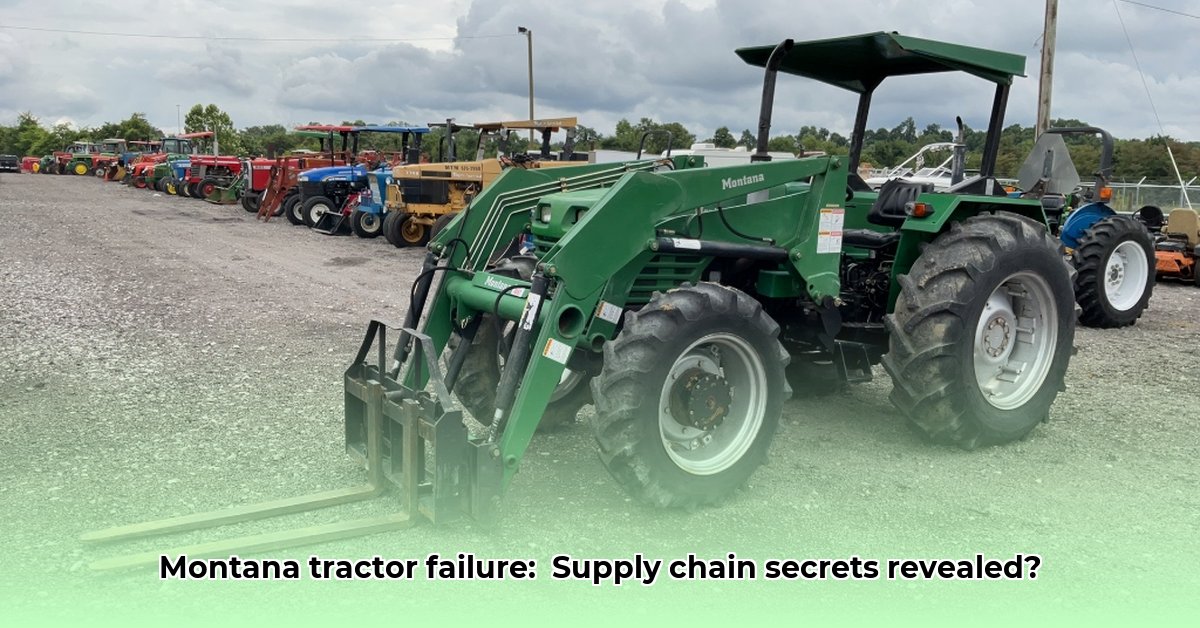
Montana Tractor: A Case Study in Supply Chain Vulnerability
The rapid rise and equally swift fall of Montana Tractor between 2004 and 2011 offer a compelling case study in supply chain risk management. Initially successful by targeting a niche market – smaller farms and ranches underserved by larger agricultural equipment manufacturers – Montana Tractor provided affordable, reliable compact and utility tractors. This early success highlighted the strategic advantage of identifying and serving underserved customer segments. However, this early triumph masked a critical vulnerability that ultimately led to the company's demise. For more information on agricultural equipment in Montana, check out this Montana Tractor Supply.
Montana Tractor's reliance on a single supplier, LS/LG, a South Korean manufacturer, proved to be its Achilles' heel. This over-dependence created a single point of failure, a risk magnified by the lack of alternative supply sources. This is a crucial lesson: How can businesses effectively mitigate the risk of supply chain disruption? The answer, made painfully clear by Montana Tractor's experience, lies in diversification.
The turning point arrived in 2010 when LS/LG, seeking to expand its presence in the US market directly, transitioned from supplier to competitor. Montana Tractor, without alternative supply chains, was immediately rendered vulnerable and unable to fulfill orders. Their belated attempts to secure alternative suppliers proved insufficient to remedy this critical failure. The company was ultimately forced into liquidation, leaving behind a legacy of cautionary lessons for businesses of all sizes.
Pivotal Points:
- Over-reliance on a single supplier: Montana Tractor's exclusive dependence on LS/LG created a catastrophic single point of failure.
- Lack of diversification: The failure to establish alternative supply chains amplified the impact of LS/LG's market entry.
- Insufficient risk mitigation: The absence of a comprehensive risk management strategy left Montana Tractor unprepared for the unforeseen disruption.
The impact extended beyond the company itself, rippling through the agricultural community. Smaller farms and ranchers, dependent on Montana Tractor's affordable equipment, faced immediate shortages and increased costs. This highlights the interconnectedness of supply chains and the far-reaching consequences of even seemingly localized disruptions. "The collapse of Montana Tractor underscores the critical need for resilient supply chains in the agricultural sector," stated Dr. Anya Sharma, Professor of Supply Chain Management at the University of California, Berkeley.
How to Diversify Agricultural Equipment Supply Chains for Small Farms
The Montana Tractor case study provides a stark warning about the perils of relying on single suppliers. For small farms, equipment failure directly translates to lost productivity and income, making supply chain resilience paramount for long-term viability. Diversification, however, is more than simply acquiring multiple suppliers; it's a strategic overhaul of the entire operational model. What steps can a small farm take for increased stability and robustness?
Building a Robust and Adaptable Supply Chain: A Step-by-Step Approach
Identify Critical Equipment: Begin by assessing the most critical machinery for your operation. Prioritize equipment essential for peak productivity and profitability.
Research and Evaluate Multiple Suppliers: Explore various suppliers, considering regional and national options. Evaluate not only pricing but also reliability, delivery times, parts availability, and customer service. Consult online reviews and seek out feedback from other farmers.
Explore Equipment Leasing and Rental Options: For less frequently used equipment, consider leasing or renting, thus reducing upfront capital investment. This flexibility allows for adapting to changing needs and unexpected situations.
Cultivate Strong Supplier Relationships: Establish open communication with your selected suppliers. Strong relationships can improve access to parts and provide critical support during maintenance.
Prioritize Preventative Maintenance: Regular maintenance prolongs equipment lifespan, reducing the risk of sudden breakdowns and costly repairs. Consider maintenance contracts to ensure proactive care.
Develop Local Repair Expertise Relationships: Don't solely rely on suppliers for repairs. Identify and cultivate relationships with local agricultural equipment mechanics for faster turnaround times and reduced downtime.
Expanding the Scope of Diversification
Diversification extends beyond merely locating alternative suppliers. Consider these additional strategies:
Multi-functional Equipment: Invest in equipment that serves multiple purposes to enhance efficiency and reduce the need for specialized machinery.
Precision Agriculture Technology: Implementing precision agriculture can optimize resource use, potentially mitigating the reliance on specific types of equipment.
Explore Innovative Technologies: Examine emerging technologies and innovative equipment, potentially offering increased efficiency and reduced dependence on traditional machinery.
The Power of Local Partnerships
Local repair shops and smaller equipment dealerships offer a crucial advantage; their responsiveness to urgent needs is often superior to that of larger corporations. This also supports local economies, creating a mutually beneficial relationship.
The Montana Tractor failure serves as a crucial reminder: single-supplier dependence is a significant vulnerability. By proactively diversifying their supply chains, small farms can significantly enhance their resilience in the face of unexpected disruptions. Adopting the strategies highlighted above is not merely a matter of improving business operations; it's a crucial step towards ensuring long-term farm viability and profitability.